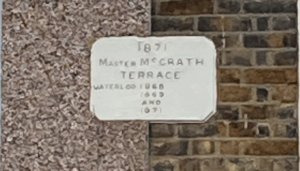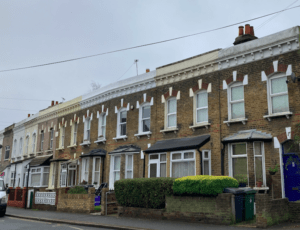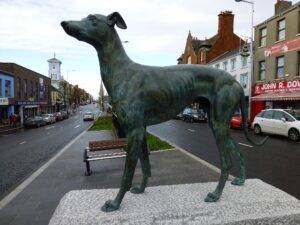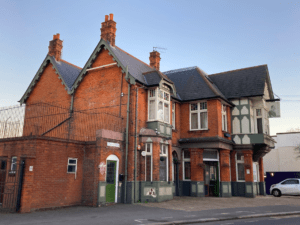Did you know that there’s a terrace of houses in Walthamstow built from the winnings of famous Irish greyhound Master McGrath?
In my obsession with local history I’m always hoping to discover something new but even I was surprised to find this plaque on a run of houses in Shernhall Street. Apologies for the poor quality of the image.

1871. Master McGrath Terrace. Waterloo 1868 1869 AND 1870

The terrace is almost opposite the former Lord Brooke pub which also features in this story. Although I know Walthamstow pretty well I only discovered this section of Shernhall Street last year whilst seeking interesting things to include in my weekly walks for Age UK Waltham Forest.
The wording meant nothing to me. Google came to the rescue.
Master McGrath was a prize-winning Irish greyhound who won the Waterloo Cup on three occasions ie the dates on the plaque and the terrace was built in 1871.
The Waterloo Cup was a hare coursing event that ran between 1836 and 2005 on the downs at Altcar near Liverpool. The Hunting Act 2004 came into force shortly after the 2005 event which put an end to it.
According to The Sphere newspaper of 17 February 1900 the Cup wasn’t directly named after the battle but was named after a pub that was named after the battle! The event was founded by William Lynn who was the proprietor of the Waterloo Hotel that once stood in Ranelagh Street in Liverpool. Lynn is probably more well known as the founder of what is now called the Grand National which he founded in 1839; although some sources put its inception three years earlier.
The Waterloo Cup was staged on Lord Sefton’s estate at Altcar and after a small-scale start with just a handful of dogs it developed into a knock-out competition between 64 greyhounds. By the late 1800s it was an event known throughout Britain which probably explains why Master McGrath became a household name even being invited to Windsor Castle for inspection by Queen Victoria.
The dog’s early history is somewhat hard to prove – well there are various versions of it – but the crux of the story is that the greyhound was given a second chance in life and turned out to be a champion at hare coursing winning the Cup in 1868, 1869 and 1871.
He nearly lost his life in 1870 when he fell through ice on a frozen river during the course of the chase but was rescued to fight another day.
He became known as ‘Greyhound of the Century’.
Master McGrath’s owner was Lord Lurgan and a statue of the dog can be seen in Lurgan, Northern Ireland.

Notafly, CC BY-SA 3.0 via Wikimedia Commons
The Ballad of Master McGrath is well known throughout Ireland – or so an Irish friend tells me. Here’s a recording by the Dubliners. The words can be found here alongside some more photos.
Dicksy as was his kennel name died at the Brownlow House Kennels, Lurgan, on Christmas Eve 1871. A post-mortem examination showed that death was caused by double pneumonia in lungs that were already extensively diseased.
Not long after his death Master McGrath’s record was eclipsed by greyhound Fullerton who was stuffed and may still be in the collection of the Natural History Museum. Actually I have just this moment discovered that there’s a branch of the NHM in Tring that focuses on stuffed animals!
That is not the end of the Walthamstow story though.
The former pub almost opposite the terrace in Shernhall Street was built in 1885 being the second pub on that site. The first pub built around 1872 was called ‘The Greyhound and Hare’ – thus linking it to the terrace across the road.

Former pub The Lord Brooke. Now a cafe.
In 1887 it became ‘The Lord Brooke’. Lord Brooke aka Francis Greville had married Lady Frances Evelyn Maynard, last lady of the Manor of Walthamstow in 1881. She was a very interesting character but it’s not relevant for this post.
1872 is the earliest record I have found for the Greyhound and Hare. This was an unsuccessful licence application by a Mr Frank Elphick. In fact all the references I have found to this pub on the British Newspaper Archive are to unsuccessful licence applications.
I already knew this name change from the amazing online ‘Behind the Bar’ 610 page book put together by Waltham Forest Oral History Workshop but there is no mention of this on other pub history websites – I will let them know!
Master McGrath continued to be a household name for many years; in fact in my research I have found an advert from 1975 for Master McGrath dog food and this has given me another fascinating site to peruse.
My delay in posting this discovery was because I have been on a quest to try to link Lord Lurgan to Walthamstow in some way. Why did an Irish trainer, whose dog won the Waterloo Cup held near Liverpool put his prize money into Walthamstow housing?
I have now realised that I am probably overthinking this and that it could just have been based on the fact that the land was ripe for development with two railway stations opening in the vicinity – what was initially called Hoe Street (now Walthamstow Central) and the temporary Shern Hall Station in Summit Road both opened in 1870.
Do you live nearby? Did you know this story? I’d love to know. Please comment below.

wonderful research and sharing. thank you